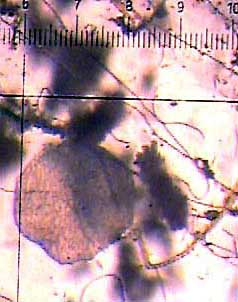The Most Simple of All Known Animals
|
Placozoans are tiny amazing animals. Very little is known about them because they have never been observed in their natural habitat. No one knows what substrate they live on or what they eat in nature. It is even unknown whether or not they reproduce sexually like most animals. They were discovered in the late 1880's living on the glass walls of an aquarium in a European laboratory. Since then, most of what has been learned about their biology has come from studying cultures of them kept alive in various laboratories around the world. Not surprisingly, given their small size and squishy nature, fossil placozoans have yet to be discovered. |
 |
|
Placozoan Morphology Placozoans are extremely simple animals. Perhaps not coincidentally, they also have the smallest amount of DNA ever measured for any type of animal. Their bodies are made up of a few thousand cells of just four types. You can compare this to sponges, which have anywhere from 10 to 20 different kinds of cells, to flies, which have roughly 90 different cell types, and to you and other mammals, which have over 200 different types of cells. Placozoans are transparent, flat, round (up to 3 millimeters across), and have two distinct sides. A tissue layer composed of two types of cells, column-shaped cylinder cells with cilia and gland cells without cilia, make up the ventral (or bottom) surface. The upper dorsal surface consists of a layer of just cover cells, which are ciliated and flattened toward the outside of the animal. The image above shows the dorsal surface of a small specimen (just over 4/10ths of a millimeter in diameter) seen from above through a microscope. The dorsal and ventral tissues appear to correspond to ectoderm and endoderm, the outer and inner tissue layers of most animals, but it is not yet known which is endoderm and which is ectoderm. The fourth type of placozoan cells are called fiber cells. These cells are star-shaped and reside in the space between the two tissue layers. The star shape results from thin extensions of the cells which connect to each other in a network. Cellular material such as microtubules and microfilaments traverse the extensions from fiber cell to fiber cell. It is hypothesized that this system of connected cells in important in coordinating the movement of placozoans. Placozoans can move in two ways, by gliding on their cilia and by changing their shape like an amoeba.
Placozoan Feeding and Reproduction
The Phylogenetic Position of Placozoa
Placozoan Diversity Learn more about Trichoplax from Richard L. Howey, whose page "A Weird Wee Beastie", is available at Microscopy-UK. |
|


